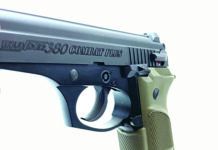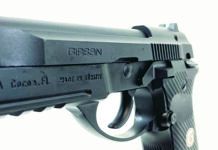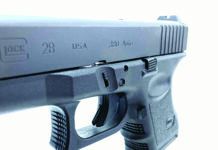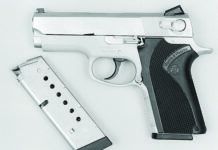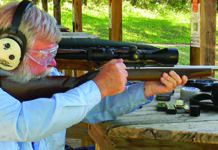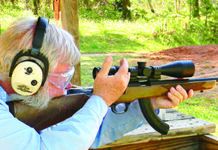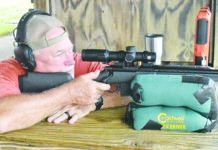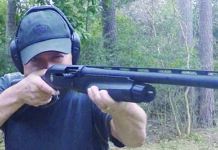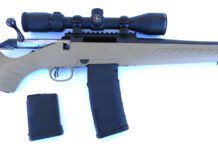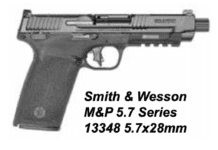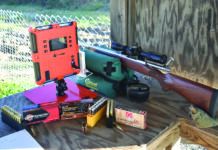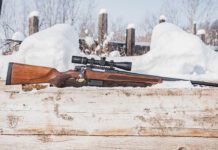Shooters who have considered purchasing a semiautomatic rifle chambered for .308 (7.62 NATO) likely balk at the question of which rifle they should buy, bypassing completely the question of whether to buy such a gun. Unquestionably, self-loading .308s are coveted by nearly everybody, mainly because they can do so much. They can compete, they can plink, they can hunt, and, of course, they’re made for self-defense, should such a situation arise.
Though there are many options if you care to search them out, there are basically three readily available rifle types in .308. They are the FAL, the M1A (M14 clone), and the HK-91. We did a several-years-long study of these three types, going to the (very costly) extent of buying two of each type and fitting them out with bipods, alternate stocks, scopes, different scope mounts, custom triggers, and more. We evaluated them as best as possible for ease of carry, function, accuracy, feel, speed to first shot, recoil, and as many other attributes as we could think of. The guns were a new Argentine FAL with bipod; a British L1A1 (FAL derivative) built of used British parts on a new receiver; a custom M14 clone based on a Polytech M14S forged and heat-treated receiver (one of the best available, in spite of what you might have read elsewhere) with Winchester barrel and other U.S. parts; a new Springfield M1A barreled action in a genuine M14 stock; a Greek HK-91 clone with thumbhole stock; and a genuine German HK-91 with three alternate stocks: collapsible, rigid, and aftermarket long-pull rigid with bipod. All of these featured chromed bores and chambers as standard equipment.
We put a $1,500 10X Leupold sniper scope in genuine Brookfield scope mount ($250 without rings) onto the Winchester-barreled Polytech M14S custom. We put a 2-8X Burris in the fine and very easily installed S&K mount onto the M1A Springfield. We mounted a Leatherwood 8X scope on solid-mount Weaver-type base onto the new Argentine FAL. We put the British L2A2 SUIT scope (about 4X) with its original British quick-detach mount onto the L1A1 rifle. We fitted the German HK-91 version with a tritium front-sight insert.
To compare the products, we test-fired all the rifles with many rounds of commonly available surplus and current factory ammo and, most important, shot all six rifles with some of the best target ammunition available, Federal’s Gold Medal Match, with 168-grain hollow-point boattail bullets.
Here’s what we thought about each one based on our results:
FAL/L1A1
Our recommendation: The L1A1, equipped as we’ve described it below, is a very good alternative to the M1A Springfield, and may be less costly. The only problem here is that you may not find one, and the SUIT scopes are starting to get rare too. We’d rate it just behind the Springfield M1A on today’s market.
The L1A1 clones are commonly seen at gun shows, sometimes with pistol-grip stocks and flash hiders. Most of them are made up of surplus British parts on new semiauto-only actions. The price varies from less than $500 for a thumbhole version up to more than $1,000 for a pistol-grip version with flash hider. One of the best receivers, and one of the first, is the Entreprise version. Rifles built on that action seem to be pretty good, but remember, all of today’s L1A1’s are made of used parts, and the overall quality of the rifle depends on the quality of its components. The original pistol grip of the L1A1 permits very easy access to the safety. This rifle will generally weigh less than a comparable M1A. Our test version weighs a half-pound less than our M14 custom, which itself is lighter than the average Springfield M1A.
The FAL rifle was just barely beat out by the M14 to become our nation’s battle rifle. Much of the rest of the world adopted the FAL as a standard rifle and used it until the .223 became common. FALs are still used in many corners of the world, and have a reputation second to none for strength and reliability. DS Arms in Illinois is currently manufacturing several types of FAL, one with a handy folding stock.
We recommend the common L1A1 version of the FAL, with its pistol-grip stock and with the L2A2 SUIT (Sight Unit, Infantry Trilux) scope if you can find one. Try to get one with the Entreprise receiver. Ours takes any old FAL magazine, either the $25 original British version or the common $5 metric. We really like the carrying handle, the adjustment for gas escape that permits the rifle to compensate for different ammo intensity and lets it lay its empties right next to you, and the handy low-power L2A2 scope with its inverted plastic post that lets you see a long-range target while holding over it. With a little practice, this scoped rifle is very fast to get into action. British troops were enthusiastic about the scope. If you don’t want it, the scope comes right off by simply pulling a lever, and the iron sights are always there. These are an aperture rear that has windage adjustment by opposing screws. Elevation is changed by sliding the rear sight up a ramp through a series of marked and detented steps. Cleaning is a breeze. The rifle breaks like a shotgun and the bolt comes out the back, so you can clean its chrome-lined barrel from the rear.
If you choose to mount a scope more permanently onto your FAL clone, there are several types that clamp to the receiver with a series of Allan screws, and which have an integral Weaver-type base. They give the very best and most rigid scope mount, but they cannot be easily or quickly removed, which is why we don’t like them on this rifle.
The iron sights on the FAL rifles are limited in their sight radius, because of the design of the rifle. Therefore, you can’t get the precise sight alignment that you can from the M1A/M14, which is another reason we like the SUIT or L2A2 scope on the British FAL.
M14/M1A
Our recommendation: The standard Springfield M1A will set you back around $1,400. It’s our first choice. It is probably the easiest of all “battle rifles” to assimilate by the rifleman who has never held a pistol-grip.
In the shooter’s hands, the classic M14/M1A stock makes the rifleman feel right at home, and its wood is more comfortable in cold weather than steel or plastic. Rifles originally designed to have a pistol grip must today have thumbhole stocks, and this tends to screw up their function to some extent. Therefore the M1A makes a lot of sense because, unlike the FAL and HK-91, it can be obtained in its original design configuration. The M1A is the most comfortable and practical .308 semiauto available, in our view. It doesn’t need any modifications to make it usable. All of the M1As we’ve examined had decent trigger pulls. If you want to put a better trigger pull on yours, that work is both easy and inexpensive to farm out. Our custom M14/Polytech/Winchester was assembled by Clint McKee at Fulton Armory, and its trigger pull is superb. There’s no better way to put it.
M1A rifles feature investment-cast receivers to which are mated some surplus and some new parts into a thoroughly sound semiauto version of the M14 U.S. rifle that beat out the FAL to become our standard battle rifle. The receiver of the M1A is extremely hard. Original M14 receivers were forged and heat treated to a slightly less but tougher final result, and that is what we have in the receiver of the Polytech M14S.
The Polytech M14S can still be found at gun shows for lots less money than the M1A, and they’re tempting. Their receivers are top quality. In fact, some well-informed individuals think they are simply modified original U.S. M14 receivers with Chinese re-marking. However, we found the stocks and some of the metal parts to be less than good, and can’t advise getting a Polytech M14S unless you want to build a custom rifle around the excellent action. This is generally more expensive than simply buying an M1A to begin with.
Concerning scope mounts for this able rifle type, the costly Brookfield used to be U.S. issue, and is extremely durable. It mounts through the use of a half-inch wrench…no sissy screwdrivers, thank you. If the rifle were run over by a truck, the scope mount would survive. However, for casual use the S&K mount is a very fine and much cheaper alternative. This simple mount has, like the Brookfield, a ridge that inserts into the groove on the left side of the action for stability, and is retained by a large-headed, serrated thumbscrew that enters the tapped hole there. For 99 percent of uses to which you might put a scope mount on one of these rifles, the S&K is more than adequate. Unlike the Brookfield, it can be easily removed.
Iron sights on the M14-type rifles are superior to iron sights on any other battle rifle we’ve seen, of any era. The sight radius is very long. The rear unit is fully and easily adjustable. If you want finer adjustments, which you probably don’t need unless you plan to shoot in competition, you can install a match rear sight. A thinner front post is available if you want one. We can easily place all shots into a 6-inch marker at near-rapid-fire rate at a full 200 yards with these sights. You don’t really need a scope with the M1A/M14.
HK-91
Our recommendation: An original German HK-91 rifle will today set you back around $1,800 if you can find one. For reasons stated below, we don’t advise buying, though we confess they’re great rifles.
H&K builds a law-enforcement-only “target” version of this battle rifle that sells for around $11,000, so you can figure this is a pretty solid bit of machinery. Heckler & Koch personnel are masters at welding, and that is how this piece of ordnance is made. It will survive being dropped from aircraft to waiting troops. It was never available as a fully-auto rifle, so if you can find a German original, you’ve got the same thing that German troops used. This ingenious design is based on the roller-locked CETME, which was done in Spain by Germans shortly after WWII. This rifle action depends on a delayed blow-back operation to cycle the bolt. The chamber is fluted. The bolt and the brass actually slide rearward before the bullet leaves the barrel, when pressure is still quite high. Empty cases are flung a long distance from the shooter, and if you find any of them, you won’t like what you see. In spite of grossly abusing the brass case, this design works extremely well. Yet it has one flaw. That bolt, blown back by gas pressure, hits the rear of the receiver a mighty blow. This rifle, even at 11 pounds without scope, kicks by far the highest of all rifles tested.
Our test rifle also had an additional flaw that eventually caused us to discard the HK-91 as a keeper, in spite of the fact that we felt it was inherently the most reliable of the three types tested. We fitted ours with the collapsible and very handy buttstock, along with a small walnut forend. A compound sling (all of this was original German equipment, very well made) completed the package. We had a tritium sight insert on the front blade, and redid the trigger pull to something very acceptable. However, the collapsible stock that we found so useful and also very light was quite short. The gun hit us in the face at every shot. The back of the HK-91 receiver is a bluff-shaped thing that would clunk us just below the eye unless we were very careful.
We tried an aftermarket long-pull stock (which might have been Australian, it resembled a FAL stock) on the HK-91 and it made shooting this rifle very comfortable. Unfortunately, with the comfortable stock installed, the weight went up to around 13 pounds fully loaded, without scope, and that’s ridiculous. A bipod made it still heavier. The only way we could tolerate the weight of the well-made HK-91 was with the light, but short, collapsible stock and that setup hit us in the face. Exit the HK-91 and all its variants.
The non-German variant was made in Greece, had a thumbhole stock, and was originally sold through Springfield, Inc. That company offers an HK-91 clone today with thumbhole stock, but with that stock on the rifle the right thumb cannot touch, much less operate, the safety. We didn’t much like this rifle until we put a pistol grip stock on it for test purposes, and by then we had, and preferred, the German version. The German welding was visibly superior. By the way, H&K really knows how to make rifle magazines. Their 20-rounders—they cost about $75 each—are splendid.
Gun Tests Recommends
If you want a bargain in this class, look for a good Entreprise-actioned L1A1 with original British buttstock. Fire it if you can, check it for accuracy and function, and be sure to get a SUIT/L2A2 scope for it. If you can get this setup for less than $800, we strongly suggest you consider it.
While you’re looking for the L1A1, buy a Springfield M1A and see if you can live without a pistol-gripped rifle. We suspect you’ll be extremely happy with the M1A. You can sell it easily if you don’t like it, but we think you won’t let your M1A go anytime soon. The purpose of a rifle is hitting targets, and this type, with its long sight radius and good trigger, make that task the easiest of all three rifle types tested. This is our first choice in a .308 rifle.
We would pass on buying the Heckler & Koch HK-91s because of their great weight, sharp recoil, and high cost.


